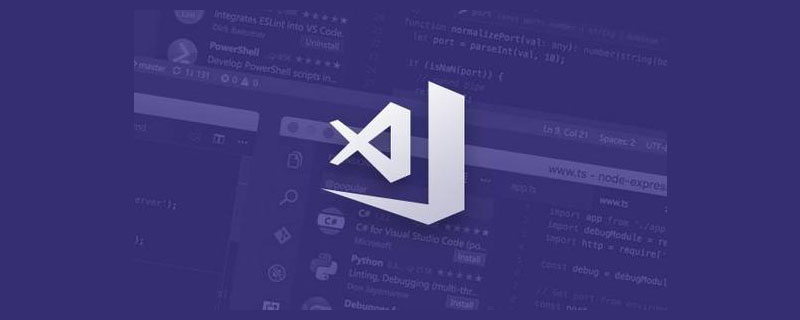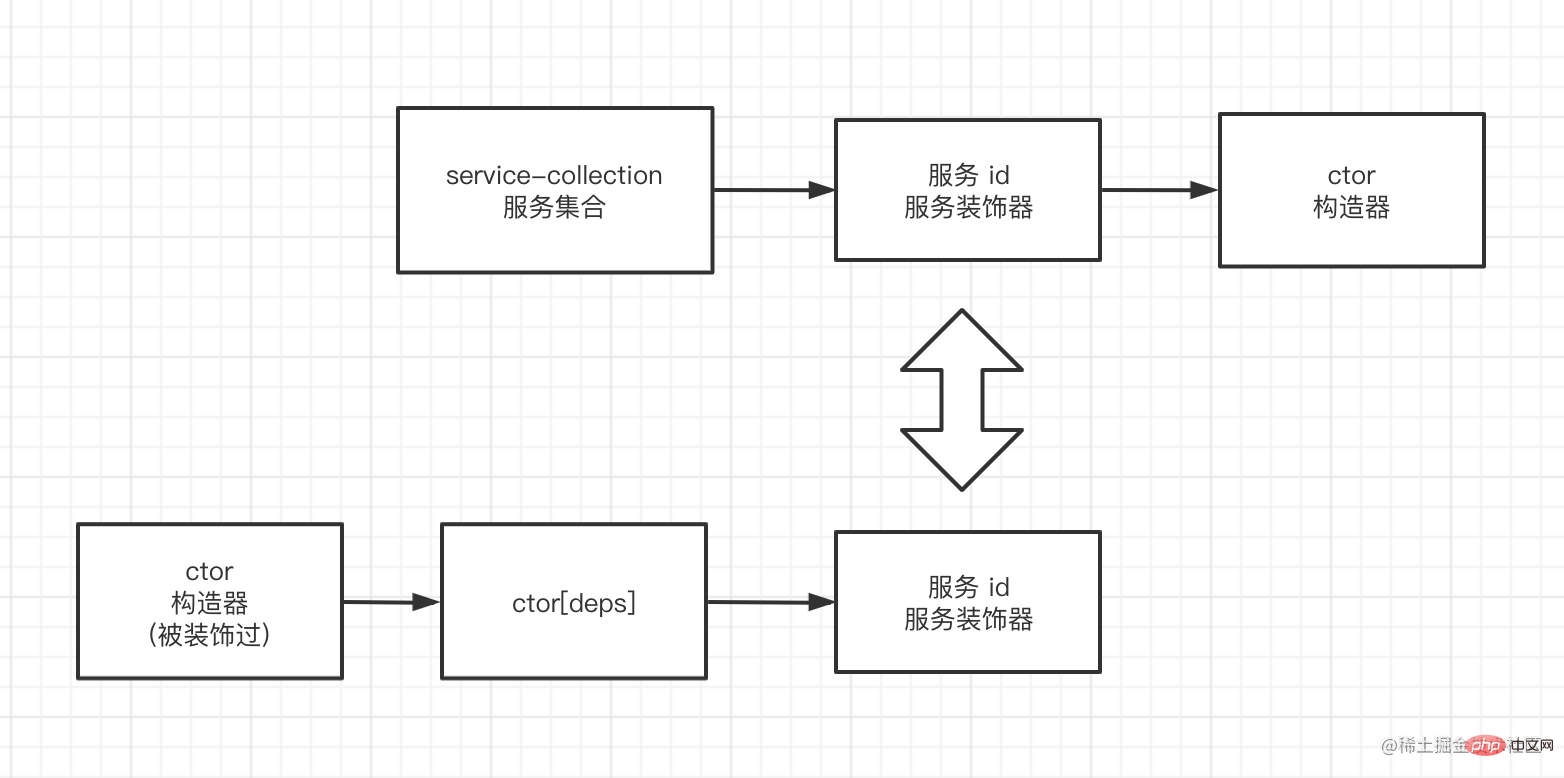Briefly talk about the principle of dependency injection in VSCode
This article will give you a brief analysis of the principle of dependency injection in VSCode. Let’s talk about what dependency injection does? How to do dependency injection? I hope to be helpful!

The team has been implementing "Dependency Injection" for a while, but every time it is used, it feels strange. There are many concepts that are always unclear: service id, service description symbols, service decorators, etc.
Maybe it’s because I don’t understand the principles, and it feels “virtual” when using it. Recently, I tried to clarify the principles by reading the source code of VS Code and the articles shared by team leaders. Here’s what I do A simple introduction to core logic.
What dependency injection does
Assume the following situation:
Service module A, dependent service B;
Service module B;
Function module Feature, dependent on services A and B;
According to the ordinary writing method, it is:
class B {}
class A {
constructor() {
// 在 A 的构造器中 new B
this.b = new B();
}
}
class Feature {
constructor() {
this.a = new A();
this.b = new B();
}
}
// 使用时
const feature = new Feature();The code is simple and clear, but there are some problems. For example: if A and B that Feature depends on need to be the same instance, the above writing method will initialize two B instances. [Recommended learning: vscode tutorial, Programming teaching]
Simple modification:
class A {
constructor(b: B) {
this.b = b;
}
}
class Feature {
constructor(a, b) {
this.a = a;
this.b = b;
}
}
// 使用时
const b = new B();
const a = new A(b);
const feature = new Feature(a, b);When a module is initialized, first externally The dependent modules are created and passed into the function module in the form of parameters. This way of writing is "Dependency Injection".
The problem with this way of writing is that in the form of manual parameter transfer, the order of new must be manually guaranteed, that is, instances of a and b must be obtained before new can be executed. Feature.
When dependencies become complex, it is likely that countless basic modules are needed before creating a functional module, and the complexity will be very high. Similar to this feeling:

Imagine a model: there is a module controller, or "service manager" to manage these dependencies:
class Feature {
// 声明这个模块依赖 idA, idB
idA
idB
}
// 告知「服务管理器」,怎么找对应的模块
services[idA] = A;
services[idB] = B;
// 使用时
const feature = services.createInstance(Feature);Isn't this service carrying the previous "manual" process?
When createInstance(Feature), analyze the modules that Feature depends on:
If the dependent module has not created an instance, recursively create the service instance and finally return;
If the module it depends on already has an instance, return the instance;
After finding everything, inject the Feature through the parameters to complete the initialization;
VSCode implements exactly such a "dependency injection system".
How to do dependency injection?
To implement such a set of functions, roughly:
How does a class declare the service id it depends on, that is, given a class, how does the outside know? What services does he rely on?
How to manage management services?
How to create a module?
The following will implement the simplest model, covering the main process.
Add dependency information
How to brand a class and declare the services it depends on?
Abstract the problem again: How to add additional information to a class?
In fact, every class is a Function under es5, and each Function is just an Object in the final analysis. As long as you add a few fields to the Object to identify the required service ID, you can complete what you need. Function.
This can be easily done by writing the "Parameter Decorator":
// 参数装饰器
const decorator = (
target: Object, // 被装饰的目标,这里为 Feature
propertyName: string,
index: number // 参数的位置索引
) => {
target['deps'] = [{ index, id: 'idA', }];
}
class Feature {
name = 'feature';
a: any;
constructor(
// 参数装饰器
@decorator a: any,
) {
this.a = a;
}
}
console.log('Feature.deps', Feature['deps']);
// [{ id: 'idA', index: 0 }]In this way, the serviceId can be obtained through Feature (which will be called constructor ctor later).
Service management
Use Map for management, one id corresponds to one service ctor.
class A {
name = 'a';
}
// 服务集
class ServiceCollection {
// 服务集合
// key 为服务标识
// value 为 服务ctor
private entries = new Map<string, any>();
set(id: string, ctor: any) {
this.entries.set(id, ctor);
}
get(id: string): any {
return this.entries.get(id);
}
}
const services = new ServiceCollection();
// 声明服务 A id 为 idA
services.set('idA', A);The schematic diagram is as follows:

Now, you can find the constructor of the dependent service through Feature
// 通过 Feature 找到所依赖的 A
const serviceId = Feature['deps'][0].id; // idA
console.log(
'Feature.deps',
services.get(serviceId) // A
);Module creation
The specific idea is:
If the dependent module has not yet created an instance, recursively create the service instance and finally return;
If the module it depends on already has an instance, return the instance;
After finding everything, inject the Feature through the parameters to complete the initialization;
Here is a simple demo, with only one layer of dependencies (that is, the dependent services do not depend on other services). To put it simply, there is no recursion capability:
class InstantiationService {
services: ServiceCollection;
constructor(services: ServiceCollection) {
this.services = services;
}
createInstance(ctor: any) {
// 1. 获取 ctor 依赖的 服务id
// 结果为: ['idA']
const depIds = ctor['deps'].map((item: any) => item.id);
// 2. 获取服务 id 对应的 服务构造器
// 结果为:[A]
const depCtors = depIds.map((id: string) => services.get(id));
// 3. 获取服务实例
// 结果为: [ A { name: 'a'} ]
const args = depCtors.map((ctor: any) => new ctor());
// 4. 依赖的服务作为参数注入,实例化所需要模块
// 结果为:[ Feature { name: 'feature', a }]
const result = new ctor(...args);
return result;
}
}
const instantiation = new InstantiationService(services);
// 使用时
const feature = instantiation.createInstance(Feature);So far , the core process of dependency injection has been implemented. When you want to use Feature, you only need to call createInstance, regardless of whether the service it depends on has been initialized. instantiation does this for us.
Summary
This article simply implements a demo-level "dependency injection" model and simply implements:
What is needed for module declaration Dependency;
Service management;
Module creation;
Based on this, you can Expand some advanced functions:
Module creation (recursive): VSCode uses a stack diagram to do this, and the algorithm is not complicated;
Dependency collection: can be used to analyze the dependencies of each module and can detect whether there is a "cyclic dependency";
Module destruction: When the module is destroyed, the services it depends on are recursively destroyed Instance;
Delayed initialization: When creating a dependent service, choose to create a proxy, and the instance will only be created when it is actually used;
Asynchronous Dependency: How to execute the creation logic when the creation process of the dependent service is asynchronous;
Source code address See the code of this article here.
Complete Function Refer to the code written by VSCode for the entire dependency injection system. For advanced information, see here.
Reference materials
VS Code source code location: src/vs/platform/instantiation/common
This article draws on code ideas, and the naming is also highly consistent (manual dog head
For more knowledge about VSCode, please visit: vscode tutorial!!
The above is the detailed content of Briefly talk about the principle of dependency injection in VSCode. For more information, please follow other related articles on the PHP Chinese website!

Hot AI Tools

Undresser.AI Undress
AI-powered app for creating realistic nude photos

AI Clothes Remover
Online AI tool for removing clothes from photos.

Undress AI Tool
Undress images for free

Clothoff.io
AI clothes remover

AI Hentai Generator
Generate AI Hentai for free.

Hot Article

Hot Tools

Notepad++7.3.1
Easy-to-use and free code editor

SublimeText3 Chinese version
Chinese version, very easy to use

Zend Studio 13.0.1
Powerful PHP integrated development environment

Dreamweaver CS6
Visual web development tools

SublimeText3 Mac version
God-level code editing software (SublimeText3)

Hot Topics
 1378
1378
 52
52
 How to define header files for vscode
Apr 15, 2025 pm 09:09 PM
How to define header files for vscode
Apr 15, 2025 pm 09:09 PM
How to define header files using Visual Studio Code? Create a header file and declare symbols in the header file using the .h or .hpp suffix name (such as classes, functions, variables) Compile the program using the #include directive to include the header file in the source file. The header file will be included and the declared symbols are available.
 What computer configuration is required for vscode
Apr 15, 2025 pm 09:48 PM
What computer configuration is required for vscode
Apr 15, 2025 pm 09:48 PM
VS Code system requirements: Operating system: Windows 10 and above, macOS 10.12 and above, Linux distribution processor: minimum 1.6 GHz, recommended 2.0 GHz and above memory: minimum 512 MB, recommended 4 GB and above storage space: minimum 250 MB, recommended 1 GB and above other requirements: stable network connection, Xorg/Wayland (Linux)
 vscode start front-end project command
Apr 15, 2025 pm 10:00 PM
vscode start front-end project command
Apr 15, 2025 pm 10:00 PM
The command to start a front-end project in VSCode is code. The specific steps include: Open the project folder. Start VSCode. Open the project. Enter the startup command code. in the terminal panel. Press Enter to start the project.
 How to set vscode
Apr 15, 2025 pm 10:45 PM
How to set vscode
Apr 15, 2025 pm 10:45 PM
To enable and set VSCode, follow these steps: Install and start VSCode. Custom preferences including themes, fonts, spaces, and code formatting. Install extensions to enhance features such as plugins, themes, and tools. Create a project or open an existing project. Use IntelliSense to get code prompts and completions. Debug the code to step through the code, set breakpoints, and check variables. Connect the version control system to manage changes and commit code.
 vscode running task shortcut key
Apr 15, 2025 pm 09:39 PM
vscode running task shortcut key
Apr 15, 2025 pm 09:39 PM
Run tasks in VSCode: Create tasks.json file, specify version and task list; configure the label, command, args, and type of the task; save and reload the task; run the task using the shortcut key Ctrl Shift B (macOS for Cmd Shift B).
 vscode terminal usage tutorial
Apr 15, 2025 pm 10:09 PM
vscode terminal usage tutorial
Apr 15, 2025 pm 10:09 PM
vscode built-in terminal is a development tool that allows running commands and scripts within the editor to simplify the development process. How to use vscode terminal: Open the terminal with the shortcut key (Ctrl/Cmd). Enter a command or run the script. Use hotkeys (such as Ctrl L to clear the terminal). Change the working directory (such as the cd command). Advanced features include debug mode, automatic code snippet completion, and interactive command history.
 What language is vscode used
Apr 15, 2025 pm 11:03 PM
What language is vscode used
Apr 15, 2025 pm 11:03 PM
Visual Studio Code (VSCode) is developed by Microsoft, built using the Electron framework, and is mainly written in JavaScript. It supports a wide range of programming languages, including JavaScript, Python, C, Java, HTML, CSS, etc., and can add support for other languages through extensions.
 What language is written in vscode
Apr 15, 2025 pm 11:51 PM
What language is written in vscode
Apr 15, 2025 pm 11:51 PM
VSCode is written in TypeScript and JavaScript. First, its core code base is written in TypeScript, an open source programming language that extends JavaScript and adds type checking capabilities. Secondly, some extensions and plug-ins of VSCode are written in JavaScript. This combination makes VSCode a flexible and extensible code editor.




